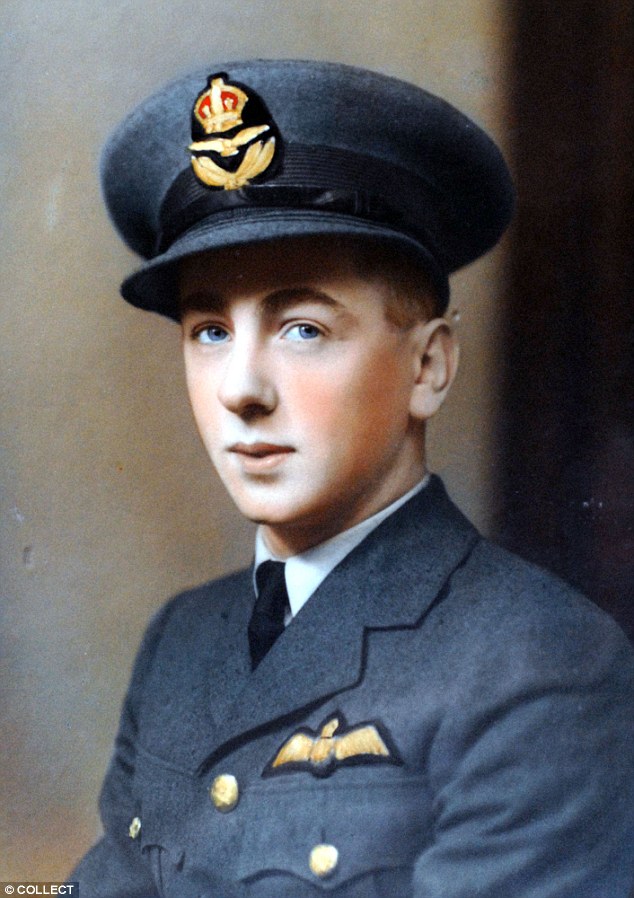The Royal Navy's most decorated pilot, Capt Eric "Winkle" Brown, has died at the age of 97.
Capt Brown also held the world record for flying the greatest number of different types of aircraft - 487.
During World War Two, Capt Brown, who was born in Leith in 1919, flew fighter aircraft and witnessed the British liberation of Bergen Belsen concentration camp.
On 4 December 1945, Capt Brown made the first ever landing of a purely jet-powered aircraft onto an aircraft carrier - HMS Ocean.
The pilot, who had been appointed MBE, OBE and CBE, died at East Surrey Hospital after a short illness.
A statement released by his family said: "It is with deep regret that the passing of Captain Eric Melrose Brown CBE DSC AFC is announced."
Eric 'Winkle' Brown: Celebrated British pilot dies, aged 97
BBC News
21 February 2016

Eric "Winkle" Brown was given the nickname "periwinkle" because of his diminutive height
The Royal Navy's most decorated pilot, Capt Eric "Winkle" Brown, has died at the age of 97.
Capt Brown also held the world record for flying the greatest number of different types of aircraft - 487.
During World War Two, Capt Brown, who was born in Leith in 1919, flew fighter aircraft and witnessed the British liberation of Bergen Belsen concentration camp.
On 4 December 1945, Capt Brown made the first ever landing of a purely jet-powered aircraft onto an aircraft carrier - HMS Ocean.
The pilot, who had been appointed MBE, OBE and CBE, died at East Surrey Hospital after a short illness.
A statement released by his family said: "It is with deep regret that the passing of Captain Eric Melrose Brown CBE DSC AFC is announced.
"Eric was the most decorated pilot of the Fleet Air Arm in which service he was universally known as 'Winkle' on account of his diminutive stature.
"He also held three absolute Guinness World Records, including for the number of aircraft carrier deck landings and types of aeroplane flown."

Capt Brown flew 2,407 aircraft carrier landings
Capt Brown was educated at Edinburgh's Royal High School, before studying at the University of Edinburgh, where he learned to fly.
He had caught the bug for flying at the age of eight when his father, a pilot in the Royal Flying Corps during World War One, took him up in a bi-plane.
"There was no second seat, but I sat on his lap and he let me handle the stick," he told the BBC in 2014.
"It was exhilarating. You saw the earth from a completely different standpoint."
He retired from the Royal Navy in 1970 but became the director general of the British Helicopter Advisory Board and later the president of the Royal Aeronautical Society in 1982.
Landmark life
Flew 487 different types of aircraft, a world record that is unlikely ever to be matched
Piloted 2,407 aircraft carrier landings
Appointed MBE, OBE and CBE
Survived 11 plane crashes and the sinking of HMS Audacity in 1941
Met Churchill and King George VI numerous times
Was at the British liberation of Bergen Belsen
Became the first pilot to land on and take-off from an aircraft carrier in a jet aircraft
Interrogated some of the leading Nazis after the war, including Heinrich Himmler, Hermann Goering and Belsen's chief guards Josef Kramer and Irma Grese

On 4 December 1945, Capt Brown made the first ever landing of a purely jet-powered aircraft onto an aircraft carrier - HMS Ocean (above)
Capt Brown wrote numerous books of his own and forewords for other authors on the theme of aviation, before and after his retirement.
In March 2015 a bronze bust of him was unveiled at the Fleet Air Arm Museum in Somerset.
At his 97th birthday celebration in London on 27 January he was joined by more than 100 pilots, including the First Sea Lord, Admiral Sir George Zambellas.
In 2014 , the war veteran was picked as the subject for the 3,000th edition of BBC Radio Four's Desert Island Discs, during which he was described by presenter Kirsty Young as a "real life hero" and a "remarkable daredevil".
"When you read through his life story, it makes James Bond seem like a bit of a slacker," she said.
On 4 December 1945, Captain Winkle Brown became the first pilot to land on and take-off from an aircraft carrier (HMS Ocean) in a jet aircraft. The aircraft he flew - the de Havilland Sea Vampire LZ551/G - is now preserved at the Fleet Air Arm Museum in Yeovilton, Somerset. Watch the video:

Capt Brown was at the British liberation of Bergen Belsen

Brown, second right, with colleagues on a Spitfire in 1944

Eric Brown's life was celebrated by BBC Radio Four's Desert Island Discs in 2014
Eric 'Winkle' Brown: Celebrated British pilot dies, aged 97 - BBC News
Capt Brown also held the world record for flying the greatest number of different types of aircraft - 487.
During World War Two, Capt Brown, who was born in Leith in 1919, flew fighter aircraft and witnessed the British liberation of Bergen Belsen concentration camp.
On 4 December 1945, Capt Brown made the first ever landing of a purely jet-powered aircraft onto an aircraft carrier - HMS Ocean.
The pilot, who had been appointed MBE, OBE and CBE, died at East Surrey Hospital after a short illness.
A statement released by his family said: "It is with deep regret that the passing of Captain Eric Melrose Brown CBE DSC AFC is announced."
Eric 'Winkle' Brown: Celebrated British pilot dies, aged 97
BBC News
21 February 2016

Eric "Winkle" Brown was given the nickname "periwinkle" because of his diminutive height
The Royal Navy's most decorated pilot, Capt Eric "Winkle" Brown, has died at the age of 97.
Capt Brown also held the world record for flying the greatest number of different types of aircraft - 487.
During World War Two, Capt Brown, who was born in Leith in 1919, flew fighter aircraft and witnessed the British liberation of Bergen Belsen concentration camp.
On 4 December 1945, Capt Brown made the first ever landing of a purely jet-powered aircraft onto an aircraft carrier - HMS Ocean.
The pilot, who had been appointed MBE, OBE and CBE, died at East Surrey Hospital after a short illness.
A statement released by his family said: "It is with deep regret that the passing of Captain Eric Melrose Brown CBE DSC AFC is announced.
"Eric was the most decorated pilot of the Fleet Air Arm in which service he was universally known as 'Winkle' on account of his diminutive stature.
"He also held three absolute Guinness World Records, including for the number of aircraft carrier deck landings and types of aeroplane flown."

Capt Brown flew 2,407 aircraft carrier landings
Capt Brown was educated at Edinburgh's Royal High School, before studying at the University of Edinburgh, where he learned to fly.
He had caught the bug for flying at the age of eight when his father, a pilot in the Royal Flying Corps during World War One, took him up in a bi-plane.
"There was no second seat, but I sat on his lap and he let me handle the stick," he told the BBC in 2014.
"It was exhilarating. You saw the earth from a completely different standpoint."
He retired from the Royal Navy in 1970 but became the director general of the British Helicopter Advisory Board and later the president of the Royal Aeronautical Society in 1982.
Landmark life
Flew 487 different types of aircraft, a world record that is unlikely ever to be matched
Piloted 2,407 aircraft carrier landings
Appointed MBE, OBE and CBE
Survived 11 plane crashes and the sinking of HMS Audacity in 1941
Met Churchill and King George VI numerous times
Was at the British liberation of Bergen Belsen
Became the first pilot to land on and take-off from an aircraft carrier in a jet aircraft
Interrogated some of the leading Nazis after the war, including Heinrich Himmler, Hermann Goering and Belsen's chief guards Josef Kramer and Irma Grese

On 4 December 1945, Capt Brown made the first ever landing of a purely jet-powered aircraft onto an aircraft carrier - HMS Ocean (above)
Capt Brown wrote numerous books of his own and forewords for other authors on the theme of aviation, before and after his retirement.
In March 2015 a bronze bust of him was unveiled at the Fleet Air Arm Museum in Somerset.
At his 97th birthday celebration in London on 27 January he was joined by more than 100 pilots, including the First Sea Lord, Admiral Sir George Zambellas.
In 2014 , the war veteran was picked as the subject for the 3,000th edition of BBC Radio Four's Desert Island Discs, during which he was described by presenter Kirsty Young as a "real life hero" and a "remarkable daredevil".
"When you read through his life story, it makes James Bond seem like a bit of a slacker," she said.
On 4 December 1945, Captain Winkle Brown became the first pilot to land on and take-off from an aircraft carrier (HMS Ocean) in a jet aircraft. The aircraft he flew - the de Havilland Sea Vampire LZ551/G - is now preserved at the Fleet Air Arm Museum in Yeovilton, Somerset. Watch the video:

Capt Brown was at the British liberation of Bergen Belsen

Brown, second right, with colleagues on a Spitfire in 1944

Eric Brown's life was celebrated by BBC Radio Four's Desert Island Discs in 2014
Eric 'Winkle' Brown: Celebrated British pilot dies, aged 97 - BBC News
Last edited:






